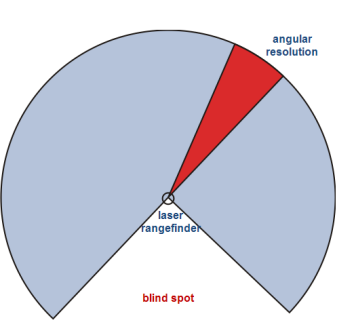In Part 1 of this article, we’ve learned how laser rangefinders use triangulation to determine how far the device is from an object. However, when robots use these devices in their navigational systems, triangulation is just half of the story. This is where we discuss the other half.
In case you haven’t read Part 1 of Robots and Laser RangeFinders, we suggest you have a look at it first.
Done? Let’s proceed.
A Neato XV-11 won’t just dive straight in and vacuum a floor when it’s sent on a cleaning mission. It will scan the room first with its laser rangefinders to map out the area and determine where the obstacles are. That way, it will be able to go through the most efficient route once it starts vacuuming.
Take note of the word ‘scan’. This basically means, the laser rangefinder won’t just be directed at a single point in the room. Rather, it will be spun around by a motor so that the laser will strike multiple objects (or points) in a very short period of time.
This is almost like how a human uses his eyes first before navigating through a set of obstacles. The main difference of course is that we scan the area and process the data more intelligently.
When a laser rangefinder conducts a scan, it first directs its laser beam at one point, takes a reading, makes a very small angular motion (mostly less than a degree), directs at another point, takes the corresponding reading, makes another tiny angular motion, and so on.
This tiny angular motion is called the angular resolution of the laser rangefinder. The smaller the value of the angular resolution, the more accurate the device is in determining distances of the obstacles around it.
Thus, if we compare Coroware’s laser rangefinders, the outdoor model has a higher resolution at 0.25 degrees compared to the indoor model’s resolution of only 0.36 degrees.
See the figure below to have an idea what we mean by angular resolution.
 Notice also that the figure is shaped into a filled arc (a.k.a. a circular sector), not a full circle. That’s because, even after one full scan, most laser rangefinders cannot cover 360 degrees. There is usually a region that cannot be scanned. This is the device’s blind spot or blind region, which is usually found at the rear side of the device.
Notice also that the figure is shaped into a filled arc (a.k.a. a circular sector), not a full circle. That’s because, even after one full scan, most laser rangefinders cannot cover 360 degrees. There is usually a region that cannot be scanned. This is the device’s blind spot or blind region, which is usually found at the rear side of the device.
Some devices, for instance, can only scan 240 degrees. To scan the blind region, they will have to be turned around. A robot will have no problem doing this though.
I guess that’s should be all for now. There’s more to talk about and we hope to cover them on our future posts. In the meantime, I hope we have covered enough to make you understand how robots like the Neato XV-11 are able to avoid furniture, walls, and other obstacles.



I went through both the part I and II of the article. I found three different method(time of flight, triangulation, Coroware’s laser rangefinder)to estimate the distance of the obstacle. Among these three what I concluded is that Coroware’s laser rangefinder is the best, reliable and accurate method to estimate the obstacle. It is different from other in such a way that it scans the whole area and process the data more intelligently. It is really good that Neato XV-11 has used this method to estimate the distance of the obstacle.
Regards,
makuta.com
I don’t think that Neato is the first manufacturer which adds to their robot rangefinder. Samsung adds to theirs sth. similar. Their robots has sth to detect too low sofas to prevents it becoming stuck and to detect door.
HI, great description of the mechanics of scanning! Can you comment on the resolution (degrees) of the LRF Neato Vac? And as with the previous comment, some description of mapping would be really nice; for instance, how often is “map” (array?) updated/compared?
-defwheezer
Excellent post. For people who don’t understand how Laser RangerFinders work (Like myself), this is a great explanation! Do you plan on discussing other aspects later on (More parts)? Do you know after the XV-11 performs an ‘initial’ scan, does it keep scanning while running? How does it map while running?